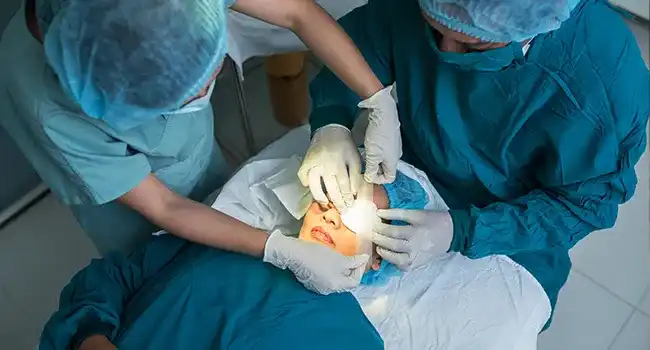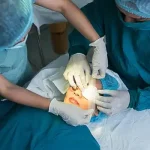If you’re prepping up for dacryocystitis surgery, knowing what to expect can make a significant difference, removing unnecessary worries. From getting ready for the day to what happens afterward, here are all the insights to keep you confident and informed every step of the way.
What Is Dacryocystitis?
Dacryocystitis is when the tear duct near your nose gets all blocked up and infected. It can make that area swell and get painful, sometimes causing gooey discharge from your eye. It’s like a traffic jam for tears, but with more discomfort!
What Is Dacryocystitis Surgery?
Dacryocystitis surgical treatment is a procedure to fix a blocked tear duct that’s causing discomfort and swelling near your nose. Surgeons remove the blockage, often creating a new pathway for tears to drain properly. It’s like giving your eyes a clear path to stay happy and healthy!
Signs You May Need Dacryocystitis Treatment
You may experience the following dacryocystitis symptoms when suffering from the condition:
- Persistent discomfort or tenderness near the inner corner of your eye, often worsening with touch.
- Noticeable swelling and redness around the eye or nose, indicating inflammation.
- Excessive tearing or watery eyes, despite no emotional triggers.
- Ongoing discharge, typically thick and yellowish, from the affected eye.
- Recurrent eye infections or irritation that doesn’t seem to clear up with basic treatments.
Eligibility for Dacryocystitis Treatment
To qualify for dacryocystitis treatment, individuals usually exhibit symptoms like continuous eye discomfort, swelling, or excessive tearing. Eye doctors may recommend treatment if remedial measures like warm compresses and antibiotics prove to be ineffective. Clinical examination along with imaging tests aid in determining your eligibility for surgical intervention to clear blocked tear ducts and alleviate symptoms effectively.
The Dacryocystitis Surgery Procedure
During dacryocystitis treatment surgery, a skilled eye surgeon performs the following steps to clear the blocked tear duct and alleviate symptoms:
Surgical procedure: The surgeon makes a small incision near the inner corner of your eye or inside your nose to access the blocked tear duct.
Clearing the blockage: Using specialized instruments, the doctor then removes any obstruction creating the blockage, such as scar tissue or debris.
Creating a new passage: In some cases, a new drainage pathway may be created to ensure tears can drain properly in the future.
After surgery, the doctor monitors the patient closely for immediate post-operative care, which includes pain management and preventing infection with prescribed medications.
What to Expect After Dacryocystitis Surgery
After dacryocystitis surgical treatment, patients are taken to a recovery area where medical staff keep an eye on their progress. Here’s what you can expect after dacryocystitis surgery:
Medications: Doctors prescribe antibiotics to prevent infection and pain relievers to manage discomfort. It is highly advised to take these medications exactly as prescribed to ensure fast healing and avoid complications.
Immediate post-operative care: Swelling and bruising around the surgical area are common. Cold compresses reduce these symptoms. The patient shouldn’t touch or rub the area to keep away the chances of irritation or infection. Doctors also apply a small bandage over the operated eye which is removed within a few days following the dacryocystitis treatment surgery.
Regular checkups: Follow-up appointments ensure recovery is on track. During these visits, doctors check for signs of infection, make sure that the incision is healing well, and monitor overall progress. Not missing out on any scheduled checkups and reporting any abnormal symptoms like increased pain, redness, or discharge helps in smooth recovery.
Dacryocystitis Treatment Aftercare
Complete recovery from dacryocystitis treatment may take a few weeks. Most people heal within 2-4 weeks. Following your doctor’s instructions closely is the safest way out. Stick to these simple yet crucial aftercare tips to get back to total healthy eyes:
- Keep it clean: Keep the area around your eyes clean and dry. Avoid touching or rubbing your eyes to prevent infection.
- Take your meds: Take all prescribed medications, including antibiotics and painkillers, exactly as directed. This helps prevent infections and manage pain.
- Use cold compresses: Apply cold compresses gently around your eyes to reduce swelling and bruising. Follow your doctor’s advice on how often to do this.
- Rest: Avoid heavy lifting and strenuous activities. Rest as much as possible to give your body the best chance to heal.
- Follow-up visits: Attend all follow-up appointments with your doctor. These checkups are important to monitor your healing and catch any potential issues early.
- Watch for issues: Keep an eye out for increased redness, swelling, pain, or unusual discharge. If you notice any of these signs, contact your doctor right away.
Benefits of Dacryocystitis Surgery
Complete relief from symptoms: The surgery quickly alleviates pain, swelling, and discomfort, helping you feel better almost immediately.
Prevents future infections: By fixing the root cause, this surgery reduces the risk of recurring infections, ensuring long-term eye health.
Better tear drainage: The procedure restores normal tear drainage, preventing tears from pooling and reducing irritation and infection.
Improved eye health: With the infection treated, your overall eye health improves, leading to fewer complications and a healthier eye condition.
Good quality of life: Eliminating discomfort and visual disturbances allows you to enjoy daily activities without the hassle of symptoms.
Quick recovery: Many dacryocystitis surgeries are minimally invasive, meaning shorter recovery times and less post-surgery pain.
Dacryocystitis Treatment: When To Go For Dacryocystitis Surgery
Dacryocystitis, an infection in the tear sac, can be more than just an occasional nuisance. Here’s when it might be time to consider surgery:
Chronic infections: If you’re dealing with frequent or ongoing dacryocystitis infections that don’t clear up with antibiotics, surgery could be the solution. Chronic infections can lead to more serious issues if left untreated.
Ongoing symptoms: Persistent pain, swelling, and eye discharge that don’t improve with other treatments are signs that surgery might be necessary. These symptoms indicate that the problem isn’t being effectively addressed.
Blocked tear ducts: Constant tearing and eye irritation due to blocked tear ducts can be resolved with surgery. This procedure can restore normal tear flow and prevent future infections.
Abscesses: If abscesses develop in the tear sac area, it’s a clear sign that surgery is needed. Abscesses are serious and require drainage and proper treatment to heal.
Impact on daily life: When dacryocystitis affects your daily activities and comfort, surgery can offer long-term relief and improve your quality of life.
Prior to Intraocular Surgeries: Chronic dacryocystitis must be treated prior to intraocular surgeries like cataract removal. This is necessary to prevent postoperative risk of infection.
Consider surgery if you experience frequent infections, persistent symptoms, tear duct blockages, abscesses, or if dacryocystitis is disrupting your daily life. Consulting with an eye specialist will help determine the best treatment plan for your condition.
Complications & Risks Associated with Dacryocystitis Surgery
Dacryocystitis surgical treatment, like any medical procedure, comes with potential side effects and risks.
Common Side Effects:
Swelling and bruising: You might notice some swelling and bruising around your eye area after surgery. This usually goes away within a few days.
Discomfort: It’s normal to experience mild discomfort or pain at the surgical site. Your doctor can prescribe medication to help manage this.
Watery eyes: Your eyes might water more than usual as your tear duct adjusts post-surgery.
Potential Risks:
Infection: While rare, there’s a slight risk of infection at the surgery site. Your doctor will give you antibiotics to reduce this risk.
Bleeding: Some minor bleeding during or after surgery can happen, but significant bleeding is uncommon.
Scar tissue: Occasionally, scar tissue may form in the tear duct area, which might need further treatment.
Healing issues: In very rare cases, the tear duct may not heal properly, requiring additional medical attention.
Long-term Considerations:
Possibility of recurrence: Dacryocystitis could come back if the underlying issue isn’t fully resolved.
Tear duct function: There’s a small chance that the tear duct could become blocked again, necessitating further treatment.
Knowing these potential outcomes helps you make an informed decision about dacryocystitis surgery. Your doctor will discuss these risks with you and take steps to minimize them for your recovery.
Dacryocystitis Operation Cost
The cost of dacryocystitis surgical treatment can vary widely based on several factors. The type of surgery, whether it’s minimally invasive or more complex, significantly impacts the price tag. Fees from the hospital or clinic, including facilities and equipment, also contribute to the total cost.
Surgeon expertise and anesthesia type and duration further influence expenses. Pre-operative tests and post-operative care, like medications and follow-up visits, add to the financial considerations. Insurance coverage and geographic location also play crucial roles in determining out-of-pocket expenses. Understanding these factors helps patients plan financially for their treatment.
FAQs
Will dacryocystitis go away on its own?
Dacryocystitis often needs medical treatment and won’t just disappear on its own. It’s your body’s way of saying it needs a bit of extra help. Reach out to a doctor for the right care.
What is the antibiotic of choice for dacryocystitis?
The preferred antibiotic for dacryocystitis is usually oral amoxicillin-clavulanate. Think of it as the right tool for the job, but it’s best to consult an eye doctor first to avoid any side effects.
What is the treatment of dacryoadenitis?
Treatment for dacryoadenitis includes warm compresses and antibiotics for infections. Quick relief and proper care start with a visit to your eye doctor.
What are the three stages of dacryocystitis?
Dacryocystitis progresses through three stages: acute, chronic, and abscess formation. It starts with sudden pain and can become a persistent issue. Always consult a doctor for proper treatment.
What is dacryocystitis surgery?
Dacryocystitis surgery usually involves dacryocystorhinostomy (DCR), creating a new tear drainage pathway. It’s like clearing a direct route for tear flow. Consult an eye specialist for personalized advice.
Is surgery always necessary for dacryocystitis?
Surgery isn’t always needed for dacryocystitis! Antibiotics and warm compresses can do the trick for mild cases. Frequent infections, though, might call for a surgical fix.
What is the cause of dacryocystitis?
Dacryocystitis happens when your tear duct gets blocked, usually from an infection. This blockage causes tears to build up, leading to pain, swelling, and sometimes discharge.
How do you treat dacryocystitis?
Dacryocystitis treatment includes antibiotics and warm compresses to ease pain and fight infection. If it keeps coming back, a minor surgery might be needed to fix the problem.
What is the difference between dacryocystitis and dacryoadenitis?
Dacryocystitis is an infection of the tear sac near the nose, causing pain and swelling. Dacryoadenitis affects the tear gland, leading to swelling and discomfort in the upper eyelid.
What medications will I need after dacryocystitis surgery?
After dacryocystitis surgery, you may need antibiotics to prevent infection and pain medication for comfort. Your doctor might also give you eye drops to help with healing and reduce inflammation.
What is the recovery time for dacryocystitis surgery?
Recovery time after dacryocystitis surgery varies but generally ranges from a few days to a couple of weeks. You can usually get back to your normal routine soon after, with mild discomfort that improves quickly.
How often will I need checkups after surgery?
After dacryocystitis surgery, your doctor will schedule follow-up appointments to check on your healing progress and ensure everything is going smoothly. These visits might be frequent initially and then less often as you recover.







